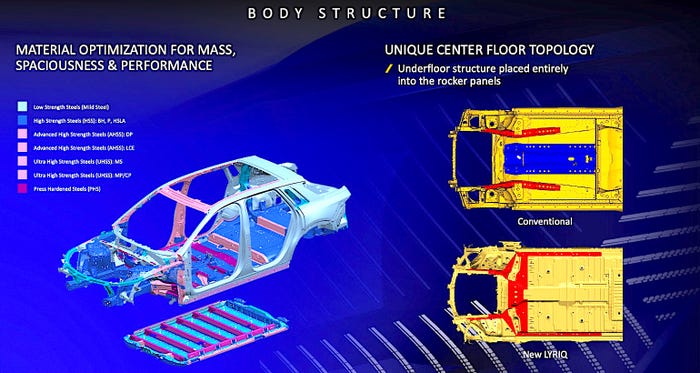2023 Lyriq Marks the Beginning of Cadillac’s EV Future
Cadillac says that the Lyriq is just the first of many EVs from the brand as it rolls out the Ultium electric drive platform.

Every new Cadillac introduced from now on will be an EV, as the brand shifts away from combustion power, and the 2023 Lyriq crossover SUV is a preview of the company’s plan to roll out a variety of upcoming cars employing General Motors’ Ultium electric drive technology.
As Cadillac’s first Ultium-based model, the Lyriq provides guidance on what we can expect from the brand in the coming years as it seeks to regain its place in the pantheon of respected premium carmakers. The key to achieving that lofty position is delivering on the promises made by designers of the concept models that stake out a coming vehicle’s attributes.
Historically, this is a fraught proposition, as engineers, designers, and accountants wrestle over what is possible, what is practical, what is desirable, and what is affordable. For Lyriq, executive chief engineer Jamie Brewer coordinated with interior design manager Tristan Murphy to ensure that the engineering team found ways to deliver the style that the designers conceived.
Collaboration between the engineering and design teams was the hallmark of the Lyriq program, Brewer told Design News in an exclusive interview. Along the way, engineers used $200 million worth of GM’s computer time to model every the Lyriq’s characteristics, she said. “By the time we got our first prototype vehicle built, we were 80 percent of the way there and could go right into tuning.”
One application of the computer-aided design (CAE) is the airflow to the rear window, which is tailored to keep the window clear without needing a rear wiper assembly. The Lyriq’s construction was carefully modeled to optimize the welding of its unibody stampings for ideal strength. “We were able to use CAE to very quickly iterate different welding types and different materials to optimize the structure,” Brewer noted.
To recap Lyriq’s previously announced specifications, recall that this version of the Ultium battery pack contains 12 modules with lithium-ion NCMA cathode, blended graphite anode cells storing 102 kilowatt-hours of power. The tested $62,155 Debut Edition Lyriq is rear-wheel drive with 340 horsepower and 325 lb.-ft of torque and a driving range of 312 miles on a full charge.

By the end of the year, Cadillac will deliver all-wheel-drive Lyriqs fitted with a front electric motor that will boost total vehicle power to 500 horsepower. Final torque specs are still being settled.
Owners can charge the Lyriq at DC fast-charging stations at as much as 190 kilowatts, which Cadillac says will add about 75 miles of range in 10 minutes. Cadillac is offering buyers a 240-volt AC home charging station that will maximize Lyriq's built-in 19.2 kW charging module, which can add as much as 52 miles of range per hour of charge, the company says.
The good news is that all of these parts deliver on the stylish promise of the whole, making a 60-something-thousand dollar electric Cadillac look like a real value when considering its driving range, features, and amenities.
The Lyriq’s ride and handling benefit from the car’s sophisticated five-link rear suspension and frequency-dependent shock absorbers. The Debut Edition Lyriq is notably light on features as the company was in a hurry to deliver cars to customers as soon as possible, so the company hinted that future versions could add more content, such as the absent head-up display system and potentially the Magneride magneto-resistive shock absorbers that have been a Cadillac signature technology since the company debuted them in the 1990s.

The resulting ride is smooth and pleasant, and the handling tops that of the disappointing BMW iX. Drivers will nevertheless not mistake the Lyriq Debut Edition as a driver’s machine. This is fine, because comfort and refinement are better benchmarks for a vehicle like this. The sluggish steering is only a disappointment when driving in switchbacks, and carving mountain roads is probably not a major use case for the Lyriq’s buyers.
Regenerative braking is a big part of the EV driving experience, and here Cadillac has given Lyriq drivers the best possible solution. The car’s one-pedal drive feature, which lets the car slow to a stop when the driver lifts off the accelerator pedal, can be set to low regeneration for a less-intrusive experience, high for those who prefer that mode, and off for drivers who want it to feel like a combustion vehicle.
And in any mode, the Lyriq’s steering-wheel-mounted paddle is available to provide proportional deceleration based on how much the driver squeezes it, so even if one-pedal drive is off, drivers can still stop the car without touching the brake pedal if they want. The low mode provides 0.23 g of deceleration, the high mode delivers 0.30 g, and squeezing the brake paddle hard slows the Lyriq with 0.35 g of force.
This kind of thoughtful application of technology makes the Lyriq an impressive start for Cadillac’s future existence as an EV-only brand once its combustion models have all been replaced. We look forward to experiencing upcoming versions of the Lyriq as Cadillac is able to add technology that was apparently not quite ready for delivery to customers this summer.
About the Author(s)
You May Also Like





